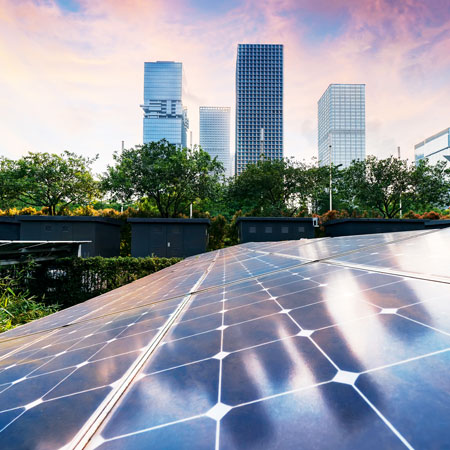The path to carbon net zero
Property companies are turning to offsetting their carbon emissions as part of their plans to become net zero. But what is offsetting and what are the options and outcomes for investors? Emily Hamilton, Head of ESG, Savills Investment Management, and Emily Norton, Head of Rural Research, Savills UK, provide the answers.
Why is the ESG agenda growing for property investors?
Emily Hamilton (EH) Market demand. Sustainability is no longer a USP, it is required for successful businesses. That has to do with policy and regulatory changes, as well as public perception – the impact of Greta Thunberg, the global climate strikes and people seeing the impacts of climate change. Covid-19 has also shown that ESG-focused funds, particularly logistics with high sustainability credentials, have been the most resilient throughout the pandemic. That provides more impetus.
How does carbon offsetting fit in?
Emily Norton (EN) It’s a way for companies to take responsibility for unavoidable carbon emissions from their businesses – by investing in environmental projects to balance out their emissions.
What role does offsetting play for property investors and their net zero agendas?
EH For the property sector, it’s difficult to get buildings to be zero carbon emissions immediately. The technology is well-developed but the funding and policy structures aren’t there yet. So, companies will need to offset some emissions to get to net zero. The other issue is that, at present, you cannot be net zero for developments because of the materials. There is no net zero carbon steel yet. So, if we are going to develop homes, schools and hospitals, then offsetting has to be part of the strategy.
What are the offsetting options?
EN Generally, you are paying for land use change or management systems that avoid land use change. For example, paying for the management of forestry rather than cutting down forests is one method to avoid land use change. Another would be to pay for the restoration of habitat that can store carbon, such as planting forests. There are risk profiles in all of those offset mechanisms and, generally, planting trees is the least risky because you can see the trees and measure the carbon.
Are we too dependent on planting trees?
EN Yes, there’s a bias towards things that are fixed and measurable, such as carbon stores with trees. Tree planting is good but it is essentially geoengineering. You’re focusing on one activity to produce a fixed outcome that can be more easily measured. Practices that restore biodiversity or offer catchment water improvements are missed as they are more complicated.
EH We are also missing out on systemic thinking. By prioritising tree planting, for example, we could be missing opportunities for whole landscape scale restoration, such as improving our rivers and soils. We also need to look beyond land-based solutions and focus more on oceans. They are our single largest carbon sink and provide habitats for more than a million species of wildlife. We are dependent on our oceans because they provide up to 70% of the earth’s oxygen, but much less focus is given to restoration projects for oceans and seas, compared with tree planting.
So, how can the industry improve?
EN With partnership schemes between organisations. Here, you might have an NGO working with local communities to create a conservation-based scheme where the carbon benefits of habitat management are sold to an investor. But these types of schemes have a more complex story and it’s harder for the investment community to engage with. It’s more bespoke but less scalable. The more unpredictable nature-based solutions also have co-benefits such as improving employment or biodiversity. But they become less investable as there’s more risk and less certainty about measurable offsetting benefits. We need to think about this because the biodiversity crisis is urgent.
Why are investors leaning towards the simpler opportunities?
EN The way that it’s accounted for is a major issue; investors need certainty of the benefits they are investing in. If you were allowed to include the co-benefits rather than just carbon storage as part of the offsetting they would be more attractive. The other thing is to find more ways of investing in carbon storage that don’t focus on permanent land use change – regenerative agriculture, for example. You’re still producing food but there is an active system of storing carbon in soil. This should allow investors to target a more diverse range of outcomes from land management.
Is there a danger that offsetting replaces the work companies should be doing to decarbonise their businesses at source?
EH Yes, in some cases that is happening because there’s no verified standard for net zero carbon. Some companies say their building is net zero carbon if they’ve just switched all their energy to green supplies. Others claim they’re zero carbon if they’ve not designed to any particular good carbon emissions standards and they’re just offsetting it all at the cheapest rate, so $7 per tonne of carbon.
EN These problems come back to the cost of a tonne of carbon. While the external cost of buying a carbon offset remains unregulated in real estate and is so cheap, it reduces the internal incentive to make the investments needed to get to net zero. It becomes more efficient to offset than it does to invest. That’s why some companies are setting aggressive, internal carbon taxes on themselves to balance the economic decision-making internally.
What is the market rate for offsetting?
EN The current market price is around $28 per tonne in the UK. However, the most progressive property companies are currently setting an internal rate of about $125. A recent report from Wood Mackenzie estimates by 2030, it will need to be $160 per tonne globally. The real estate sector needs to adopt this upper figure.
How do you expect offsetting to evolve?
EN More sophistication, where investors understand the trade-offs and mechanisms of a more complex approach. Innovation in data and technology is simplifying the complexity here. We’re seeing more demand for accredited carbon off sets and a more transparent and accountable system of off setting.
What guidance is there for investors?
EH It’s increasing. The UK Green Building Council’s best practice guidance has eight carbon off set principles that include aspects such as being measurable, independently verifi ed and representing permanent emission reduction and removal. Additionality is another important factor. A project needs to demonstrate that it could not have taken place without the off setting fi nance and achieves more than it would have if it had not been carried out.
Are there also ways for companies to help set offsetting levels and disclose them?
EH There isn’t a standardised approach. The Better Buildings Partnership in the UK has a net zero carbon framework, which encourages companies to reduce emissions and set out transparently what their net zero carbon pathway covers. This is probably the best we have, and many companies adopting this have global footprints, so that is becoming more influential. Some real estate companies are also using Science Based Targets (SBT) which provide a clearly defined path to reduce emissions, but this isn’t always the best fi t for property as they focus on Scope 1 emissions, which are direct emissions under a company’s control, such as fuel combustion and fleet vehicles, and Scope 2, which are indirect emissions from electricity purchased and used by the company. While SBT does include Scope 3 indirect emissions associated with buildings and development, such as waste, the methodology is less robust than the methodology applied to Scope 1 and 2 emissions. SBT are working on updating this. There is also the Task Force on Climate-related Financial Disclosures (TCFD), which supports on the risks and opportunities of the climate crisis, and includes carbon emissions as an indicator.
Is regulation playing a role?
EH Cities are leading the way. London and New York have set pretty strict targets. If you don’t achieve London’s targets for carbon emissions for new developments you have to pay £95 per metric tonne. In New York, it’s $125 per metric tonne. The monetary authority of Singapore has strict guidelines as to what they expect asset managers to report and is using the TCFD for that.
Are there broader environmental outcomes for property investors in offsetting?
EH If it’s done at a large enough scale it could really start to stimulate regenerative projects. For example, could we link up with a client’s other managers because we’re doing this as a property investment manager? What are the other asset classes doing? If you could find a way to collaborate, if we need to offset then we could be supporting the wider corporate environmental aims of many organisations to go beyond singular tree planting or one-off renewable energy projects. Personally, I’d love to see investment in greening our cities at scale.
EN If we can put offsetting into more restorative and, in the end, regenerative projects, then you’re starting to restore the natural environment at a more linked-up level than it just being about carbon. Everyone is so focused on carbon, we will miss out on broader opportunities to create really great places. You might have a good carbon building but a sterile environment because all your efforts are in the building and not enough in the planting around it.
Should offsetting be a short-term solution in the overall drive to reduce emissions?
EN In a way, yes. Ideally, every property should be regenerative. It should be contributing more economic, social and environmental capital than it’s consuming within its own limits, rather than saying that its negative environmental consequences need to be offset.
Journey to net zero
Spain
In 2019, Spain reduced emissions by 6.2% while global emissions remained flat. Real estate has been galvanised by national government priorities and local decarbonisation strategies. “This is not only because it will be mandatory in 2030, but it represents a key positioning in the market and a differentiation from competitors,” says David Hernández Núñez, Senior Consultant, Technical Property Management, Savills Aguirre Newman. Longer term, the industry has ambitious plans with LEED, BREEAM and passivhaus targets. “Real estate companies want to push the envelope to have better outcomes,” says Barbara Recio Pelayo, Associate Director, Savills Aguirre Newman. “They have already tested that lower emissions are often related to a better ROI.”
Journey to net zero
China
China is at the start of its journey. For now, only a few Chinese real estate companies have announced their own targets. “Once policies are in place, the real estate industry will respond quickly,” says Marco Meng, Head of Property and Asset Management, Savills China. “As well as following government guidelines, they are motivated by the need to futureproof assets, and the chance to enhance occupancy and rent levels.” Companies from Hong Kong, Taiwan and international developers in China are more advanced in their initiatives. Hong Kong’s Shui On has signed up to the Science Based Targets. Another initiative for companies active in China is mindful MATERIALS, which provides information on the sustainability of building materials.
Offsetting projects
Vilcabamba Amboró Conservation Corridor, Peru
This project aims to improve the livelihood of local communities, reduce unplanned deforestation and conserve biodiversity. Activities include sustainable forest management in Forest Stewardship Council-certified timber concessions. Since 2009, the project has had total emissions reduction of 660,000 tonnes CO₂ equivalent per annum.
Community chlorofluorocarbons destruction, Ghana
This is a grassroots programme to collect cans and cylinders of chlorofluorocarbons (CFCs), aggregate the refrigerant inside, and dispose of the material without harming the environment. This is done through partnership with a recycling centre in Pokuase, Ghana. Other benefits include providing formal employment and reducing unauthorised and environmentally-harmful burning of electric cables.
Woodland & habitat creation, Cairngorms National Park, Scotland
This landscape scale project is a native woodland and habitat creation scheme across a total of 1,900 hectares in the Cairngorms National Park. Planting is due to start in winter 2022 and, over its lifetime, this project will sequester 400,000 tonnes of carbon, as well as increasing the biodiversity and habitat connectivity of the landscape. The carbon sequestered will be used as an internal offset, with a view to commercialising surplus carbon units.



